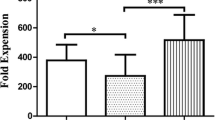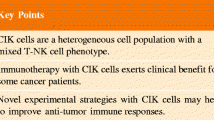Summary
The generation of lymphokine activated killer (LAK) cells by recombinant IL2 (rIL2) in collaboration with interferonγ (IFNγ) was examined in peripheral blood mononuclear cells (PBMC) from patients with malignant tumors of the digestive organs and breast cancer. LAK cytotoxicity could be induced by rIL2 at 10 units/ml in 10 of 12 patients and 20 of 37 using fresh autologous tumor cells and PK-1, an established solid tumor cell line as a target, respectively. Among 34 patients, in which titers of IFNγ produced were assayed, 12 showed no IFNγ production. All of these 12 patients had no or extremely low LAK activity, suggesting the correlation of LAK generation with the production of IFNγ in response to rIL2. LAK induction by rIL2 in PBMC of cancer patients was almost completely inhibited by addition of anti-IFNγ serum. Depressed LAK generation, which was accompanied by no or low levels of IFNγ production, was partially restored by addition of exogenous recombinant IFNγ. These results indicate that LAK induction by rIL2 in cancer patients involves the production of IFNγ and its interaction with rIL2.
The results also suggested the presence of a factor(s) suppressing LAK induction by rIL2 in the serum of cancer patients. Based on these results, the cancer patients could be divided into the following three groups. Group 1, in which the serum suppressor activity was undetectable, had the same level of LAK cytotoxicity in PBMC as healthy controls. Group 2 showed the serum suppressor factor and had the lower level of cytotoxicity in PBMC when cultivated in autologous serum (AS) compared to healthy controls. The depressed LAK induction in AS medium was restored to a normal level in culture with fetal calf serum (FCS) plus rIL2, or by addition of rIFNγ, or high concentrations of rIL2 in AS medium. The last group (group 3), in which the serum suppressor factor was also found, had the lowest level of cytotoxicity compared to healthy controls. The LAK induction in these patients could not be restored to a normal level by culture in FCS medium, addition of exogenous rIFNγ or high concentrations of rIL2, suggesting the possibility that the deficit of LAK generation in this group might involve the dysfunction or the lack of IL2 responder cells, in addition to the presence of a serum suppressor factor(s).
Similar content being viewed by others
References
Brooks WH, Netsky MG, Normansell DE, Horwitz DV (1972) Depressed cell mediated immunity in patients with primary intracranial tumors. J Exp Med 136:1631
Cheever MA, Greenberg PD, Fefer A, Gillis S (1982) Augmentation of the antitumor therapeutic efficacy of long-term cultured T lymphocytes by in vivo administration of purified interleukin 2. J Exp Med 155:968
Devos R, Cheroutre H, Taya Y, Degrave W, Vanhereverswyn H, Fiers W (1982) Molecular cloning of human immune interferon cDNA and its expression in eukaryotic cells. Nucleic Acids Res 10:2487
Djeu JY, Kasahara T, Balow JE, Tsokos (1983) An interleukin 2 (IL-2) inhibitor is present in normal sera and is decreased in sera of patients with connective tissue disorders. Clin Res 31:342
Giuliano AE, Rangel D, Golub SJ, Homes EC, Morton DL (1979) Serum mediated immunosuppression in lung cancer. Cancer 43:917
Grimm EA, Mazumder A, Zhang HZ, Rosenberg SA (1982) Lymphokine-activated killer cell phenomenon. Lysis of natural killer-resistant fresh solid tumor cells by interleukin 2 activated autologous human peripheral blood lymphocytes. J Exp Med 155:1823
Grimm EA, Ramsey KM, Mazumder A, Wilson DJ, Djeu JY, Rosenberg SA (1983) Lymphokine-activated killer cell phenomenon. II. Precursor phenotype is serologically distinct from peripheral T lymphocytes, memory cytotoxic thymus-derived lymphocytes, and natural killer cells. J Exp Med 157:884
Grimm EA, Robb RJ, Roth JA, Neckers LA, Lachman LB, Wilson DJ, Rosenberg SA (1983) Lymphokine-activated killer cell phenomenon. III. Evidence that IL2 is sufficient for direct activation of peripheral blood lymphocytes into lymphokine-activated killer cells. J Exp Med 158:1356
Handa K, Suzuki R, Matsui H, Shimizu Y, Kumagai K (1983) Natural killer (NK) cells as a responder to interleukin 2 (IL2). II. IL-2 induced interferon production. J Immunol 130:988
Hardt C, Rollinghoff M, Pfizenmaier K, Mosmann H, Wagner H (1981) Lyt-23+ cyclophosphamide-sensitive T cells regulate the activity of an interleukin 2 inhibitor in vivo. J Exp Med 154:262
Hellström KE, Hellström I (1974) Lymphocyte-mediated cytotoxicity and blocking serum activity to tumor antigens. Adv Immunol 18:209
Hellström I, Warner GA, Hellström KE, Sjogren HO (1973) Sequential studies on cell-mediated tumor immunity and blocking serum activity in ten patients with malignant melanoma. Int J Cancer 11:280
Itoh K, Shiiba K, Shimizu Y, Suzuki R, Kumagai K (1985) Generation of activated killer cells by recombinant interleukin 2 (rIL2) in collaboration with interferonγ (IFNγ). J Immunol 134:3124
Itoh K, Tilden AB, Kumagai K, Balch CM (1985) Leull+ lymphocytes with natural killer (NK) activity are precursors of recombinant interleukin 2 (rIL2)-induced activated killer (AK) cells. J Immunol 134:802
Kasakura S (1977) Cytotoxic lymphocytes induced by soluble factors derived from the medium of leukocyte cultures. J Immunol 118:43
Klein E, Vanky F (1981) A review. Natural and activated cytotoxic lymphocytes which act on autologous and allogeneic tumor cells. Cancer Immunol Immunother 11:183
Lotze MT, Frana LW, Sharrow SO, Robb RJ, Rosenberg SM (1985) In vivo administration of purified human interleukin 2. I. Half-life and immunologic effects of the Jurkat cell line-derived interleukin 2. J Immunol 134:157
Mazumder A, Rossenberg SA (1984) Successful immunotherapy of natural killer-resistant established pulmonary melanoma metastasis by the intravenous adoptive transfer of syngeneic lymphocytes activated in vitro by interleukin 2. J Exp Med 159:495
Merluzzi VJ, Savage DM, Mertelsmann R, Welte K (1984) Generation of nonspecific murine cytotoxic T cell in vitro by purified human interleukin 2. Cell Immunol 84:74
Rosenstein M, Yron I, Kaufmann Y, Rosenberg SA (1984) Lymphokine activated killer cells: Lysis of fresh syngeneic natural killer resistant murine tumor cells by lymphocytes cultured in interleukin 2. Cancer Res 44:1946
Seely JK, Golub SH (1978) Studies on cytotoxicity generated in human mixed lymphocyte cultures. I. Time course and target spectrum of several distinct concomitant cytotoxic activities. J Immunol 120:1415
Shiiba K, Itoh K, Shimizu Y, Kumagai K (1984) Interleukin 2 (IL-2)-dependent proliferation of human NK cells accompanied by interferon γ production. In: Hoshino T, Koren HS, Uchida A (eds) Natural killer activity and its regulation, Excerpta Medica, Amsterdam Princeton Geneva Tokyo p 187
Strausser JL, Mazumder A, Grimm EA, Lotze MT, Rosenberg SA (1981) Lysis of human solid tumors by autologous cells sensitized in vitro to alloantigens. J Immunol 127:266
Suzuki R, Handa K, Itoh K, Kumagai K (1983) Natural killer cells as a responder to interleukin 2 (IL2). I. Proliferative response and establishment of cloned cells. J Immunol 129:981
Vanky F, Stjernsward J, Klein E, Steiner L, Lindberg L (1973) Tumor associated specificity of serum-mediated inhibition of lymphocyte stimulation by autochthonous human tumors. J Natl Cancer Inst 51:25
Vose BM, Vanky F, Fopp M, Klein E (1978) In vitro generation of cytotoxicity against autologous human tumor biopsy cells. Int J Cancer 21:588
Whittaker MG, Ress K, Clark CG (1971) Reduced lymphocyte transformation in breast cancer. Lancet I:892
Author information
Authors and Affiliations
Rights and permissions
About this article
Cite this article
Shiiba, K., Suzuki, R., Kawakami, K. et al. Interleukin 2-activated killer cells: generation in collaboration with interferonγ and its suppression in cancer patients. Cancer Immunol Immunother 21, 119–128 (1986). https://doi.org/10.1007/BF00199859
Received:
Accepted:
Issue Date:
DOI: https://doi.org/10.1007/BF00199859




